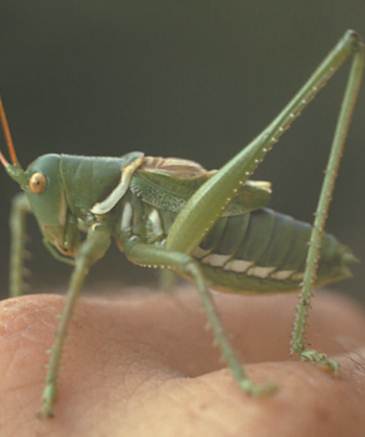Insect
Insects are a class of arthropods. Like other arthropods, they have exoskeletons made from the carbohydrate chitin, segmented bodies, and jointed appendages. Insects are distinguished by having three major body segments (head, thorax, and abdomen), with three pairs of legs attached to the thorax. Ancestral head appendages have been modified to form antennae and mouth parts, while abdominal appendages are either absent or modified to aid in reproduction. Most insects possess wings as adults, also attached to the thorax.
Sensory Systems
The insect head bears a single pair of compound eyes, composed of many individual units, called ommatidia, each of which senses a small portion of the visual field. Hunting insects such as the dragonfly may have thousands of ommatidia per eye, while others, such as ants, have many fewer. A single pair of antennae serves as chemical sensors to help find food or mates. In many species, including the tobacco hornworm moth, the female releases airborne chemicals called pheromones that attract the male. The highly branched antennae of the male moth can detect the molecules of the female pheromone, and can track the scent to find the female over very long distances. Chemoreceptors are also located on the feet, allowing an insect to taste its food as it walks across a leaf or a table. The numerous hairs covering the insect body are linked to mechanoreceptors, which aid its sense of touch. Some mechanoreceptors can sense changes in air pressure, useful for flying or evading a swooping predator. Receptors for carbon dioxide, water, and temperature also exist.

A katydid. Insects are distinguished by having three major body segments (head, thorax, and abdomen), with three pairs of legs attached to the thorax.
Ingestion, Digestion, and Excretion
Insect mouth parts vary tremendously in their shapes, reflecting adaptations to a wide variety of feeding habits. Mosquitoes, for instance, have a long hypodermic needlelike stylet, perfect for piercing skin to suck blood. Butterflies and moths, among others, have a very long, flexible strawlike mouth part, the proboscis, which they unfold to sip nectar from the base of flowers. Houseflies have a spongy tonguelike labrum for sopping up a variety of foods. Grasshoppers and beetles have small, sharp mouth parts adapted for chewing. The insect gut is divided into three regions, with most digestion occurring in the midgut. Suspended into the midgut are the Malpighian tubules, which filter nitrogenous waste from the blood and deposit it as crystals within the gut, avoiding the water loss that urine formation would entail. In termites, the hindgut houses a complex group of protists and bacteria that digest wood.
Legs and Wings
Insect legs are used for walking and climbing. In some predatory species such as the praying mantis, the front pair of legs has been modified for capturing prey, with barbed surfaces that hold other insects tightly. Almost all insects have wings, although a few primitive forms do not. In the ants, only the reproductive members of the colony have wings, which they shed after their “nuptial flight,” in which they mate with members of the opposite sex.
Respiration and Circulation
Insects do not have lungs, but instead employ a highly branched network of internal tubes, called tracheae, to deliver oxygen to the tissues. Tracheae connect with the atmosphere through openings in the exoskeleton called spiracles. Insect circulatory systems transport nutrients and wastes in a fluid called hemolymph, which is pumped into and out of internal chambers surrounding the organs, an arrangement called an open circulatory system.
Reproduction and Development
Most insects reproduce sexually, although the aphids are a notable exception. Aphids reproduce by parthenogenesis, in which the egg develops into a new organism without fertilization. In honey bees and some other social insects, only one female per colony reproduces, and males are haploid, whereas females are diploid, a system called haplodiploidy. The queen produces new (diploid) females (workers, soldiers, and future queens) from fertilized eggs. Males are produced from eggs that are not fertilized, and thus males are haploid.
Insects vary in their degree of metamorphosis during development. Butterflies, beetles, and flies, for example, undergo complete metamorphosis, in which the egg hatches into a feeding larva, which then pupates. Within the pupa, the larval tissues dissolve and rearrange into the adult form. In contrast, grasshoppers, cockroaches, and cicadas undergo incomplete metamorphosis, emerging from the egg as a miniature adult, but minus the wings and genitals. To grow, all insects must molt, or shed their exoskeleton, which then reforms around the larger individual.
Metamorphosis often allows juvenile and adult individuals of the same species to avoid competition for food. Larval moths feed voraciously and can be significant agricultural pests, while adult moths either don’t feed or consume only nectar.
Diversity
Insects are the most diverse of all groups of organisms, with over 800,000 species named and many thousands, probably millions, yet to be discovered. Insect diversity may be linked to their close association with the angiosperms (flowering plants). The Coleoptera (beetles) are the most diverse of all insect orders, with at least 350,000 species, representing one fourth of all known animal species. (Asked what could be inferred about the work of the Creator from a study of His works, British scientist J. B. S. Haldane is reported to have quipped, “An inordinate fondness for beetles.”) The evolutionary reasons for the mind-boggling diversity of this single order are not clear. Other major orders of insects include the Diptera (flies), Hymenoptera (bees and wasps), Hemiptera (true bugs), and Lepidoptera (moths and butterflies). Note that each name describes the wing (ptera means “wing”). For instance, Diptera means “two wings,” referring to the presence of only one wing pair in this order. In the Coleoptera (“sheath wings”), the first pair of wings is modified into a hard covering for the rear pair, which is easily observed in a lady beetle, for instance.
References
Berenbaum, May. Bugs in the System. New York: Addison-Wesley, 1995.
Daly, H. V., J. T. Doyen, and A. H. Purcell. Introduction to Insect Biology and Diversity. New York: Oxford University Press, 1998.
Evans, Arthur V., and Charles L. Bellamy. An Inordinate Fondness for Beetles. New York: Henry Holt & Company, 1996.
Fabre, Jean Henri. Fabre’s Book of Insects. Mineola, NY: Dover Publications, 1998.

















